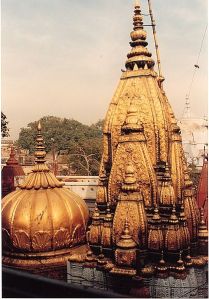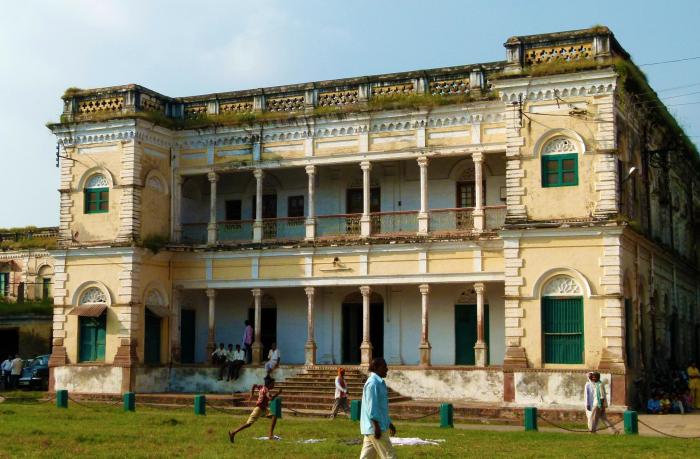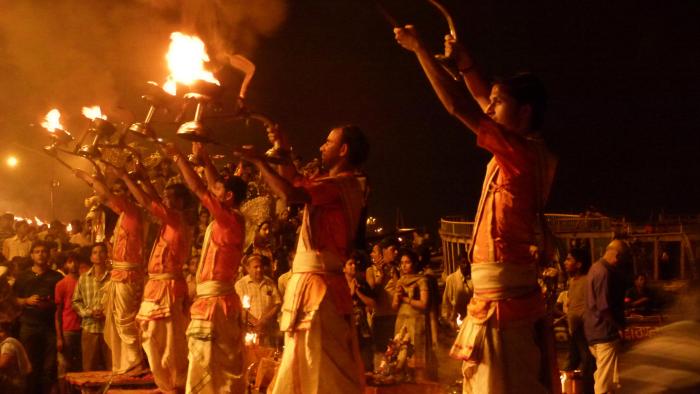 6.15 am, 6th October 2011. It is Dussera day or Vijaya Dashami. I am standing at the steps of Chausatthi Ghat in Varanasi, outside my hotel, taking in the early morning scene before me. The sun has just risen and the ghats and the Ganga are bathed in a rosy light. Many tourists are already out on an early morning boat ride, while many more are walking towards the nearby Dashashwamedh Ghat to go on one. Still more people are walking purposefully with puja offerings, while others are having a dip in the holy Ganga and saying their morning prayers. Temple bells can be heard in the distance, as do morning aarti prayers at a nearby shrine.
6.15 am, 6th October 2011. It is Dussera day or Vijaya Dashami. I am standing at the steps of Chausatthi Ghat in Varanasi, outside my hotel, taking in the early morning scene before me. The sun has just risen and the ghats and the Ganga are bathed in a rosy light. Many tourists are already out on an early morning boat ride, while many more are walking towards the nearby Dashashwamedh Ghat to go on one. Still more people are walking purposefully with puja offerings, while others are having a dip in the holy Ganga and saying their morning prayers. Temple bells can be heard in the distance, as do morning aarti prayers at a nearby shrine.
The temple bells shake me out of a reverie and remind me that I need to be on my way to the Kashi Vishwanath Temple, which is the first temple I have decided to visit on Dussera. Also known as Golden Temple by the locals (due to the gold-plated temple dome and spire), the Kashi Vishwanath Temple is a 20-minute walk from Chausatthi Ghat through Dashashwamedh Ghat, a crowded market, the Vishwanath Dwar, impossibly narrow, slippery, twisting lanes, and 4 security checks. Since I am aware of strict security restrictions, I don’t carry my cameras or cell phone (this also meant that I could not photograph any of the temples I visited 😦 ). For added measure, I also do not carry a purse or a bag, keeping my money in my trouser pockets. This turns out to be a wise decision as the security waves me through the long line of devotees waiting for darshan with bags, cell phones and what not, and in no time I am at the entrance of the Kashi Vishwanath Temple.

Inside the temple, it’s surprisingly peaceful. After placing my offerings at the sacred lingam in the main shrine, I take my time to wander around the premises. I visit the gyanvapi well (whose waters are supposed give wisdom) and see the mosque, which was built by the Mughal Emperor Aurangzeb on the earlier site of the Kashi Vishwanath Temple, from across the dividing wall.
The temple of Kashi Vishalakshi, considered by many to be a Shakti Peeth, is the next temple I visit. It is some distance away and a couple more security checks and more twisting lanes later, I am standing before the deity. This place is practically empty and offering prayers here, I pay visits to the Annapoorneshwari Temple and then the Prachin Brihaspati Temple.
I hire an auto rickshaw to visit the next set of temples, as they are not within walking distance. The overwhelmingly red-coloured Durga Temple is the next temple I visit. Even though I love the colour red, it is a little difficult to stomach the red colour scheme on everything—walls, spires, floors, everything. I say a quick prayer and leave immediately for the next temple, the Satyanarayan Tulsi Manas Mandir. In direct contrast to the red Durga Temple, this temple is a soothing white.
The Tulsi Manas Temple is a two-storied temple with the entire Ramcharitmanas of Tulsidas inscribed on the walls. I spend time reading the passages and searching for my favourite ones on the walls, and walking around the grounds, which has scenes from the Ramayana re-created there.
From here, it is a short visit to the Tridev Mandir, which has Sarasar Hanuman Bhagwan, Dadi Rani Sati Devi and Khatu Ji Maharaj as the three deities, and then to the Sankat Mochan Temple. In spite of it being Dussera day, it is not too crowded and the few people there were busy reading the Hanuman Chalisa. I too pick up a Hanuman Chalisa to read and when I finish it, I feel incredibly calm and peaceful. There is something about this temple that I cannot really describe in words apart from saying that it has a very strong spiritual “atmosphere” or ambience.

The last temple I visit is the new Kashi Vishwanath Temple, which is also known as the Birla Mandir as it was built by the Birlas. Located in the lush green and beautiful campus of the Benares Hindu University, the pink and white temple is supposed to be a replica of the original Kashi Vishwanath Temple. Located in well maintained grounds, I saw many varieties of flowers and butterflies there. The unique feature of this temple is that it is open to people from all castes and religions. In addition to the main lingam and a beautiful Nandi, there are various shrines within the temple.
It is past noon when I returned to my hotel for some lunch and a nap before leaving for the next leg of celebrating Dussera in Varanasi—a visit to the Ramnagar Fort, about 15 km from away by boat. The Fort is in Ramnagar town, which is known the world over for the month-long Ramlila it conducts before Dusshera, wherein the inhabitants of the town turn into actors.

- View of the Ramnagar Fort from the river side
Ramnagar Fort is the residence of the Kashi Naresh or the King of Varanasi, who is considered to be a descendent of Lord Shiva. Raja Anant Narayan Singh is the current Kashi Naresh, who is the religious, ceremonial and cultural head for all important ceremonies in Varanasi. He is also the Chancellor of the Benares Hindu University.

I hope to see the archaeological museum, which is reputed to have many rare manuscripts and illustrations. But when I arrive at the Fort, I find it packed with people, the museum closed on account of Dussera, members of the Varanasi royal family seated on the balcony, and Kashi Naresh conducting a puja. Before I can even think “camera”, one of the spectators warns me that photography is forbidden. He is a local and keeps a watchful eye on me to see that I do not take any photographs. I had to be content with only watching the elaborate proceedings.
Once the puja and abhishek is over, the Kashi Naresh waves to the crowds and goes inside a building. This is the signal for the assembled people to disperse, including my ‘watcher’. It is only after he leaves, that I am able to quickly take a few photographs.

- A beautiful building within the Ramnagar Fort Complex

Made of sandstone, the Ramnagar Fort was built in the 18th century. It is full of carved and arched balconies, pavilions and open courtyards, typical of Mughal style architecture. Part of the Fort complex is not accessible to the public as the Kashi Naresh still resides there. And what is accessible to the public is beautiful, but a little run down.
 As my boat makes its return journey to Varanasi, I rue my chances of missed photo-ops at the Ramnagar Fort, but can also not help admiring the respect and reverence that the people of Varanasi and Ramnagar have for their King and how protective they are of him.
As my boat makes its return journey to Varanasi, I rue my chances of missed photo-ops at the Ramnagar Fort, but can also not help admiring the respect and reverence that the people of Varanasi and Ramnagar have for their King and how protective they are of him.
It is nearly 5.30 pm by the time I reach my hotel, just in time for some tea and a wash before going for my evening programme—the Ganga Aarti at the Dashashwamedh Ghat, which takes place every evening at 7.00 pm.
The Dashashwamedh Ghat’s Ganga Aarti is one event that all guide books, touristy articles, and travel blogs recommend every visitor to Varanasi to attend. I had seen so many photographs of the Ganga Aarti and read about it, that I was looking forward to seeing and participating in it. Since I had read that crowds turned up by the hundreds to see the aarti, I decided to be at the venue by 6.30 pm. The Ghat is just a 2-minute walk from my hotel and when I arrive I find that not only is the aarti going to take place there, but also the immersion or visarjan of Durga idols. There is a barge filled with devotees singing the most beautiful bhajans in Bangla, while a priest does the final aarti for a Durga idol before the visarjan.


Another Durga idol is getting ready to be loaded on the barge for the visarjan, while there are more idols coming down the steps of the Dashashwamedh Ghat for visarjan. The atmosphere is charged with cries of “Durga maiyya ki jai” and Jai mata di” and devotees are singing and dancing with gay abandon. Many more people are sitting calmly on the steps of the Ghat watching the proceedings or praying and waiting for the Ganga Aarti to begin. Many others, mostly women, are lighting tiny lamps and floating them in the Ganga.
In the midst of all this, the saffron and cream clad pandas or priests who will be doing the aarti are getting ready. A large number of boats are gathered around the Dashashwamedh Ghat to watch the Ganga Aarti from the river. Photographers are jostling for prime position to be able to capture the entire ceremony. In the midst of all this, dazed looking foreign tourists wander about here and there. I am mesmerised by what is going on around me and try to capture the same in my camera, even though I know that the camera will never be able to record the energy and emotions there. After a while, I just put the camera away and watch what is happening around me.
At 7.00 pm, the Ganga Aarti begins to pre-recorded music. It is a stunning, choreographed act that lasts for about 30 minutes (and deserves a blog post of its own). Five priests conduct the aarti with flowers, incense sticks, conch shells, oil lamps and camphor. The whole area is bathed in a golden light and the effect is quite ethereal and dramatic at the same time, and it is impossible not to be affected by the whole thing.

When the Ganga Aarti finishes, the crowd disperses silently, the tourist-filled boats move away and pandas collect the aarti items to be taken away and kept in a safe location. As I retrace my steps to the hotel, I am hailed by a chaatwala who tempts me with his banarsi aloo chana papdi chaat. I love chaat and need no persuasion to buy some. I decide to have my chaat on the steps of the Chausatthi Ghat It is delicious and perfect in every sense and enjoy every spoonful.
There is nobody around except for the twinkling lights of the oil lamps set afloat earlier in the evening. And I suddenly realise that this Dussera day I have spent in Varanasi has been like no other—morning with the Gods, afternoon with the King, and evening with the Ganga. Absolutely perfect and divine. 🙂
♦ ♦ ♦ ♦ ♦ ♦ ♦ ♦ ♦
Related Posts

i walked some steps into the hallowed place
of where a river assumes the grace
of a goddess and a revered mother
whose name and fame are matched
by no other..
and wandered around the ramparts
of a legendary city
of kings and queens and
serene divinity..
Sometimes the pictures
of the mind,
are lovelier and a tad
more kind..
In a way very hard to describe
the dawn, the morn and
also the eventide
have melted into
the bubbling pot
of what consists
of my most
beautiful thoughts..
LikeLike
It was such a beautifully, divine day, Deepa, that this post has just about managed to convey, and your poetry has managed to enrich. Thank you.
LikeLike
lovely account of your trip 🙂 🙂
LikeLike
Thank you, Sunita 🙂
LikeLike
I have also been to Varanasi, albeit during my ‘unseeing’ days but could not have written a more evocative and descriptive post than this one, even if I could have seen everything. Relived it by proxy (Had not got gone to Ramgarh though). Thanks for sharing..
LikeLike
Ramnagar Fort is beautiful and sort of dilapidated. The view from the Fort must be incredible, but since I could not experience it, I only imagined it. I am so glad that you liked the post. I was afraid that it might be too long and boring.
LikeLike
I agree it was the best way to spend the day. 🙂
LikeLike
Thank you, ndinamoni. How did you spend your Dussera?
LikeLike
I am away from home. So, there is no celebration. 😦 Just like any other day. I’m still waiting for pazhampori
LikeLike
Aww… I know the feeling. I spent a year in London and missed Diwali so much that it seems funny now, because I don’t like Diwali at all. And then came Holi, which also I missed and which was even funnier as I don’t play Holi. An Indian friend and I got together and put a show for some of our non-Indian friends and we had a blast. It went a long way in making us feel better. Maybe you too could do the same. As for the pazhampori, be patient 🙂
LikeLike
Wonderful account of the trip Sudhajee! You made me nostalgic as well, Varanasi is one city very close to my heart.. many many thanks for sharing this 🙂
LikeLike
Thank YOU, Arti. Reading your posts on Varanasi actually helped me to get and idea of what to see and of course, once I reached there, I just went with the flow. Literally. I am so happy that you liked the post. 🙂
LikeLike
beautiful snaps and wonderful info …
LikeLike
Welcome here, Ashish, and thank you so much for stopping by and commenting. Glad you liked the pictures and the information given here. 🙂
LikeLike
a wonderful account of your visit!
wonder why the photophobia…
LikeLike
I’m not too sure about the reasons for the photophobia, but can guess. The Kashi Naresh is a considered to be descendent of Lord Shiva and therefore holy, and therefore not to be photographed.
Thank you so much for your comments. 🙂
LikeLike
what alovely way to spend Dasera you will recall this day always. I have visited Varanasi ages back & remember the boat ride. It was mystical.
LikeLike
Thank you Arnavaz. Varanasi is indeed a very special place, in spite of the dirt, filth, dust and chaos.
LikeLike
Wow. You made Varanasi come alive. I just finished reading Revolution 2020 which is based on Varanasi and you saved me searching on google for places in Varanasi. Thanks. The pictures are beautiful the one of Ganga, boat ride and Arti. Is the place dirty? Just wondering why did you visit Varanasi? No offense but people prefer to go to mountains, beaches or outside the country.
LikeLike
Welcome here and thank you for stopping by and commenting. And I am so happy that you liked the post. Varanasi is a pilgrimage site, sorry the mother and father of all pilgrimage sites for Hindus. And like any other place, it is dirty and filthy, and perhaps more so. And yet, it has a magical quality that simply rises above the filth. As for choosing Varanasi, I really don’t know. It was more of a why not? I like history and places with character and Varanasi gave me plenty of both.
LikeLike
Lovely post. It reminds me of the bygone days of sweet childhood.
LikeLike
Thank you, Umashankar. I’m glad the post brought back happy memories. 🙂
LikeLike
wonderful post!
LikeLike
Welcome here, Geeta, and thank you for stopping by and commenting. I hope that you’ll keep visiting. 🙂
LikeLike
What a wonderful way to celebrate Dusshera!
LikeLike
Yes, it was and absolutely divine way to celebrate Dussera. I have never spent Dussera like this and I don’t think that I ever will ! 😀
LikeLike